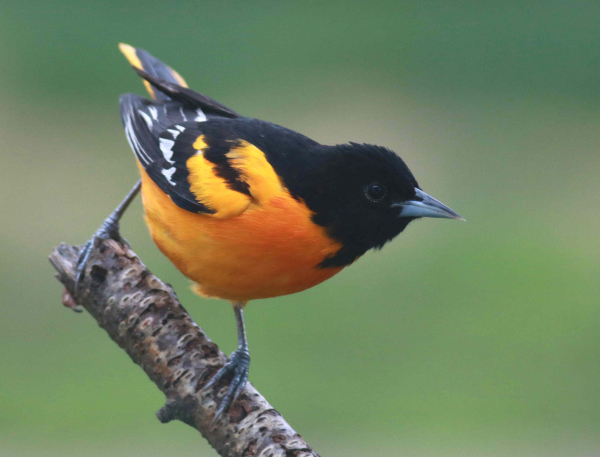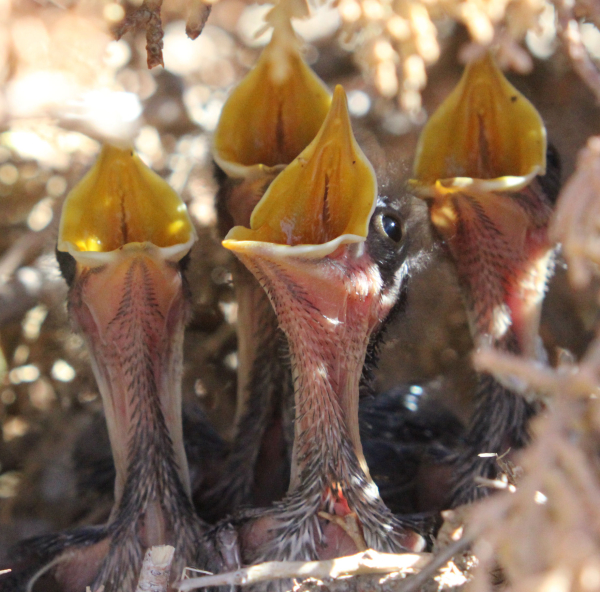
Baltimore Orioles lay 4 or 5 eggs per clutch, incubate the eggs 12 to 14 days until they hatch, then feed and care for nestlings 12 to 14 more days before they leave the nest. Oriole fledglings continue to be fed and protected during the post-fledging period while they learn to fly and find food for themselves.

Female Northern Mockingbirds lay a clutch of 3 to 5 eggs, which they incubate about 13 days, then feed and care for the nestlings about 11 days before fledging. These mockingbird nestlings are about 4 days old (photos by Paul Konrad).

House Wrens are favorite backyard birds that nest in a natural cavity, woodpecker-excavated cavity, or a nest box provided by birders. For such a small bird, it’s quite a surprise to learn that females may lay 6 to 8 eggs per clutch, and rarely more.
|
The nesting season is an exciting time anywhere, and when it includes your own yard, it becomes more personal and provides a chance to learn more about the birds around us. As birders wish to learn more about the birds we share their yards and neighborhoods with, there are great sources for us to do that online, at a library, or in your library of books about birds. Even so, thought you would be interested in information about familiar backyard birds that provides the average clutch size, the number of days in the incubation period, and the number of days nestlings spend in the nest before fledging – all in one location.
Most backyard favorites tend to raise altricial nestlings that spend a number of days in the nest as they grow. The adults, or just the female in some cases, brood nestlings until their body can warm themselves, and the adults also feed the nestlings while they grow and produce feathers. Below you can find and compare many details about some of the birds you see out your windows and in your neighborhood:
Species: Clutch Size, Incubation Period, Nestling Period to Fledging
American Robin: 4 eggs, 13 days incubation, 15 days to fledging
Northern Mockingbird: 3-5 eggs, 13 days incubation, 11 days to fledging
Baltimore & Bullock’s Orioles: 4-5 eggs, 12-14 days incubation, 12-14 days to fledging
Northern Cardinal: 3-4 eggs, 12-13 days incubation, 11-12 days to fledging
Eastern Bluebirds: 4-5 eggs, 13 days incubation, 15-20 days to fledging
Mountain Bluebirds: 4-6 eggs, 13 days incubation, 22-23 days to fledging
American Goldfinch: 4-6 eggs, 10-12 days incubation, 11-17 days to fledging
Lesser Goldfinch: 4-5 eggs, 12 days incubation, 12-16 days to fledging
House Wren: 6-8 eggs, 13 days incubation, 12-18 days to fledging
Bewick’s Wren: 5-7 eggs, 13 days incubation, 13-17 days to fledging
Carolina Wren: 5 eggs, 13 days incubation, 12-14 days to fledging
Black-capped Chickadee: 6-8 eggs, 11-13 days incubation, 14-18 days to fledging
Carolina Chickadee: 6 eggs, 11-12 days incubation, 12-18 days to fledging
Tufted Titmouse: 5-7 eggs, 13 days incubation, 13-17 days to fledging
Ruby-throated Hummingbird: 2 eggs, 11-14 days incubation, 14-21 days to fledging
Anna’s Hummingbird: 2 eggs, 14-19 days incubation, 18-23 days to fledging
Broad-tailed Hummingbird: 2 eggs, 14-17 days incubation, 21-26 days to fledging
Downy Woodpecker: 4-5 eggs, 12 days incubation, 20-25 days to fledging
Northern Flicker: 5-8 eggs, 11-14 days incubation, 25-28 days to fledging
White-breasted Nuthatch: 5-8 eggs, 12 days incubation, 14 days to fledging
Blue Jay: 4-5 eggs, 16-18 days incubation, 17-21 days to fledging
Common Grackle: 4-5 eggs, 13-14 days incubation, 16-20 days to fledging
American Crow: 4-6 eggs, 18 days incubation, 28-35 days to fledging
Enjoy the summer as you share the season and your neighborhood with the birds that are attracted to your landscaping, bird bath, and feeding station! To learn more about the birds you encounter, the ultimate reference is the Birds of the World website at https://birdsoftheworld.org/bow/home
Share your birding experiences and photos at editorstbw2@gmail.com